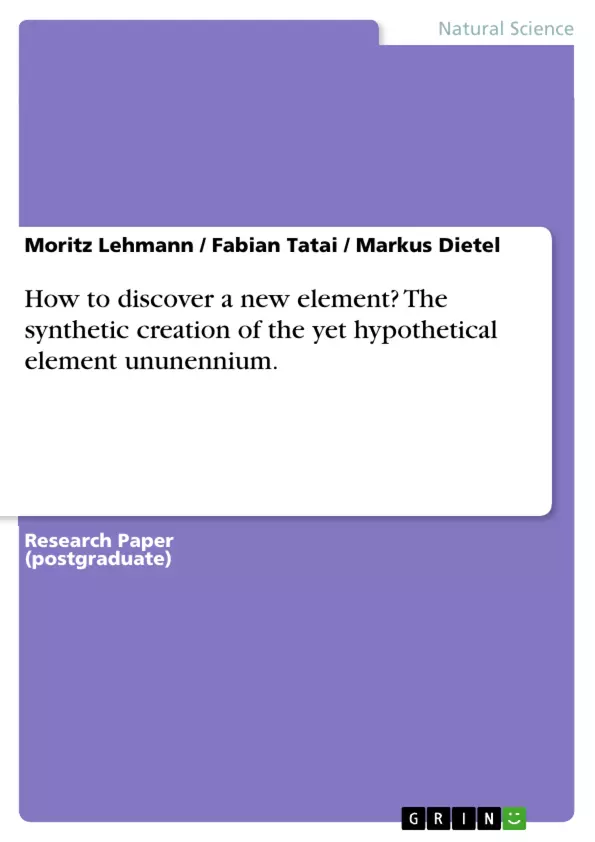This document describes how to theoretically create the yet undiscovered element ununennium with the atomic number 119 using the Proton Synchrotron (PS) particle accelerator in Geneva as well as how its existance can be verifyed. All necessary calculations are provided.
It was originally designed as a proposal for the CERN beamline for schools competition.
Table of Contents
- I. Experiment
- II. Evidence
- 2.1 Direct evidence
- 2.2 Evidence with decay
Objectives and Key Themes
The objective of this work is to outline a plan for the synthetic creation of the hypothetical element ununennium (Uue) with atomic number 119. The process involves colliding lead-208 and rubidium-87 ions to achieve fusion. The success will be verified through direct observation or by detecting the characteristic decay products.
- Synthetic element creation
- Nuclear fusion reactions
- Energy calculations in nuclear reactions
- Particle detection methods
- Decay processes of unstable isotopes
Chapter Summaries
I. Experiment: This chapter details the proposed experimental procedure for synthesizing ununennium (Uue). It describes the planned use of a low-energy lead-208 ion beam from LINAC 3 directed at rubidium-87 targets. The rationale behind the choice of these specific isotopes is explained, emphasizing the existing infrastructure for handling lead-208. The chapter focuses on the calculation of the necessary kinetic energy for successful fusion, utilizing the Bethe-Weizsäcker formula to approximate the mass and binding energy of the resulting Uue nucleus. The calculation considers the transformation of kinetic energy into binding energy during the collision, utilizing principles of conservation of momentum. Relativistic corrections to the calculations are also discussed, utilizing the Maple computer algebra system to refine the determination of the required ion beam velocity. The chapter concludes by outlining the plan to use LEIR and PS to accelerate and concentrate the lead ions before directing them toward the rubidium targets in test room T9.
II. Evidence: This chapter presents two methods for verifying the successful creation of ununennium. The first, direct evidence, involves using a mass spectrometer or a Lead Crystal Calorimeter to directly detect the Uue ions after they have traveled a short distance from the target. A magnet or Wien filter would help separate different particles within the beam. The second method focuses on indirect evidence through the detection of decay products. Since Uue is expected to be highly unstable, its decay into daughter nuclei, such as Uus, and the emission of particles like alpha particles (helium nuclei), positrons, or neutrons, are used as confirmation. The chapter details how the energy and trajectory of these decay products, as measured by a Delay Wire Chamber and Lead Crystal Calorimeter, can be used to infer the presence of Uue. Calculations regarding the energy released during the decay of Uue into Uus and He²+ are presented, emphasizing the conservation of momentum.
Keywords
Ununennium, nuclear fusion, Bethe-Weizsäcker formula, binding energy, kinetic energy, particle detection, mass spectrometry, Lead Crystal Calorimeter, decay products, alpha particles, conservation of momentum, relativistic calculations, LINAC 3, LEIR, PS.
FAQ: Ununennium Synthesis Experiment
What is the main objective of this work?
The primary goal is to detail a plan for the synthetic creation of the hypothetical element ununennium (Uue), atomic number 119, through the fusion of lead-208 and rubidium-87 ions.
What methods are proposed for creating Uue?
The proposed method involves colliding lead-208 and rubidium-87 ions to achieve nuclear fusion. The specific isotopes are chosen based on existing infrastructure and the feasibility of achieving the necessary fusion energy.
How will the success of Uue synthesis be verified?
Verification will be achieved through two methods: direct observation of Uue ions using a mass spectrometer or Lead Crystal Calorimeter, and indirect observation by detecting the characteristic decay products of Uue (e.g., alpha particles, positrons, neutrons) using a Delay Wire Chamber and Lead Crystal Calorimeter.
What are the key themes explored in this document?
Key themes include synthetic element creation, nuclear fusion reactions, energy calculations (kinetic and binding energy) in nuclear reactions, particle detection methods, and decay processes of unstable isotopes. The Bethe-Weizsäcker formula and relativistic calculations play a significant role in energy estimations.
What experimental setup is planned?
The experiment will utilize a low-energy lead-208 ion beam from LINAC 3 directed at rubidium-87 targets. LEIR and PS accelerators will be used to accelerate and concentrate the lead ions before directing them towards the targets in test room T9.
What are the key calculations involved?
Key calculations include determining the necessary kinetic energy for successful fusion using the Bethe-Weizsäcker formula, considering the transformation of kinetic energy into binding energy, and applying relativistic corrections using the Maple computer algebra system. Calculations regarding energy released during Uue decay are also crucial.
What instruments will be used for particle detection?
The proposed instruments include a mass spectrometer, a Lead Crystal Calorimeter, and a Delay Wire Chamber to detect Uue ions and their decay products. A magnet or Wien filter will aid in separating different particles within the beam.
What are the expected decay products of Uue?
Uue is expected to be highly unstable and decay into daughter nuclei, such as Uus, and emit particles like alpha particles (helium nuclei), positrons, or neutrons.
What principles of physics are applied in this experiment?
The experiment relies heavily on principles of nuclear physics, including nuclear fusion, conservation of momentum, and the relationship between kinetic and binding energy. Relativistic effects are also considered in the calculations.
What are the key words associated with this research?
Key words include Ununennium, nuclear fusion, Bethe-Weizsäcker formula, binding energy, kinetic energy, particle detection, mass spectrometry, Lead Crystal Calorimeter, decay products, alpha particles, conservation of momentum, relativistic calculations, LINAC 3, LEIR, PS.
- Quote paper
- Moritz Lehmann (Author), Fabian Tatai (Author), Markus Dietel (Author), 2014, How to discover a new element? The synthetic creation of the yet hypothetical element ununennium., Munich, GRIN Verlag, https://www.hausarbeiten.de/document/289334


